Black pepper’s the king of spices, right? Boom—suddenly, you’re out.
No sweat, because we’ve got the lowdown on the top 5 black pepper swaps that’ll save your dish in a pinch.
Think about it: every kitchen scramble turns into a fun flavor experiment with these backups. No black pepper? No problem.
From the cozy warmth of cumin to the zing of white pepper, these alternatives are about to make your meals unexpectedly awesome.
Stick around as we spill the beans on making your dishes pop, even when the pepper grinder’s bone dry. Ready to shake things up?
What is Black Pepper?

Let’s start with the basics.
Black pepper is a flowering vine in the family Piperaceae, cultivated for its fruit, usually dried and used as a spice and seasoning.
Black pepper is native to south India but has strongly permeated cuisines across the world throughout history because of its widespread use in food preservation techniques before the era of refrigeration.
When dried, the fruit, known as a peppercorn, is approximately 5 millimeters (0.
20 in) in diameter, dark red when fully mature, and, like all drupes, contains a single seed.
The word “pepper” has become a common term for the ground spice made from the piper berries, which may be described as “ground pepper” but is more often referred to as “pepper”.
There are three main ways to use black pepper, whether as peppercorns or ground up into a fine powder.
Its main use is as a food additive to add spiciness, taste, and flavor to savory dishes.
However, it can also be used for medicinal purposes or as decoration, such as the traditional Indian spice mixture known as garam masala.
The 5 Best Substitutes for Black Pepper
Black pepper is a widely used spice known for its distinct flavor and aroma.
However, if you run out of black pepper or prefer alternatives with different taste profiles, there are several substitutes that can provide a similar seasoning experience.
In this guide, we will compare the top 5 substitutes for black pepper, discussing their key characteristics and suggesting proper ratios to ensure excellent results in your culinary creations.
| Substitute | Key Characteristics | Proper Ratio |
|---|---|---|
| White Pepper | Mild heat with a slightly different flavor profile compared to black pepper | Use an equal amount of white pepper as a substitute for black pepper |
| Green Peppercorns | Fresh and slightly fruity with a milder heat than black pepper | Use an equal amount of green peppercorns as a substitute for black pepper |
| Sichuan Pepper | Citrusy and numbing sensation with a unique flavor profile | Use an equal amount of Sichuan pepper as a substitute for black pepper |
| Pink Peppercorns | Mild heat with a sweet and fruity taste | Use an equal amount of pink peppercorns as a substitute for black pepper |
| Coriander Seeds | Mild heat with a warm, citrusy flavor | Use an equal amount of coriander seeds as a substitute for black pepper |
Now let’s dive into each substitute in more detail:
1 – White Pepper
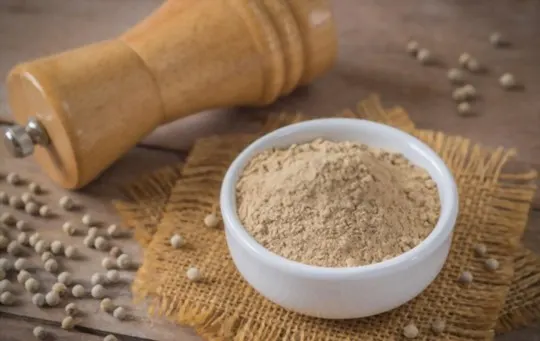
One of the most common substitutes for black pepper is white pepper.
White pepper is produced from the same fruit as black pepper, but its production process differs.
The piper nigrum fruits are soaked in water to remove the outer layer of the fruit.
This layer contains the majority of the pigment found in peppercorns.
Once this step has been completed, the fruit is dried, removing all the water and leaving behind a small seed.
The difference between these two products comes down to color.
White pepper contains no pigment and has a milder flavor than black pepper.
The white color comes from the lack of skin, which typically contains most pigment found in peppercorns.
- Key Characteristics: White pepper has a milder heat compared to black pepper and offers a slightly different flavor profile. It is commonly used in lighter-colored dishes to avoid speckling.
- Proper Ratio: Use an equal amount of white pepper as a substitute for black pepper. Adjust the quantity based on your taste preferences and recipe requirements.
2 – Green Peppercorns
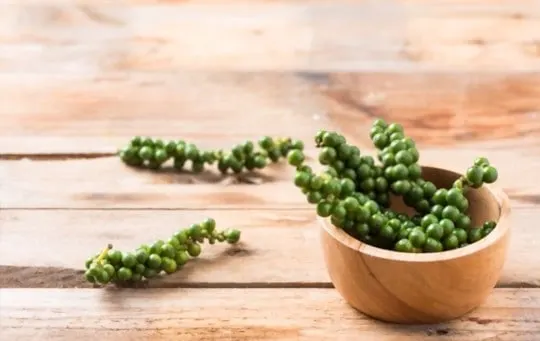
Green peppercorns are a different variety of pepper, similar to black pepper.
This spice is grown on a vine and packed as soon as harvested.
It must be preserved this way as it’s considered too delicate to be dried.
Green peppercorns are incredibly similar to black pepper, but they are milder.
The flavor is typically less intense, and the color of green peppercorns tends to vary from a bright green hue to a dark olive-green color.
You can find this spice in most grocery stores, but it is important to note that ground-up green peppercorns are not the same as fresh green peppercorns.
The latter typically has a higher price tag because of their fragility and lack of availability.
- Key Characteristics: Green peppercorns are harvested before they fully ripen, resulting in a fresh and slightly fruity flavor. They have a milder heat compared to black pepper and can add a unique touch to your dishes.
- Proper Ratio: Use an equal amount of green peppercorns as a substitute for black pepper. Adjust the quantity based on your taste preferences and recipe requirements.
3 – Sichuan Pepper
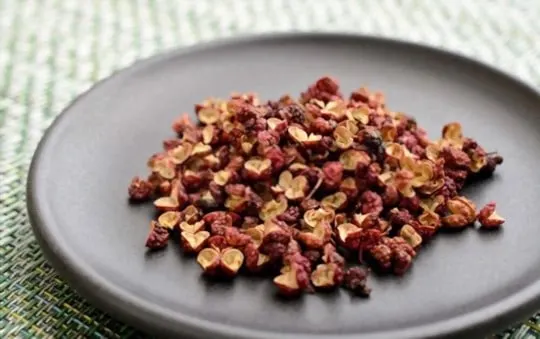
Sichuan pepper is a special kind of peppercorn used frequently in Chinese cuisine.
This type of pepper has a unique flavor, so much so that it’s considered an acquired taste.
The flavor of Sichuan peppercorns is described as being sharp, tingly, and slightly sweet.
Some believe the flavor is similar to a mix of black pepper and citrus.
The peppercorns are typically roasted and then finely ground to make this spice.
It’s important to note that Sichuan peppercorns will lose their flavor if added to food too long after being cooked.
There are tons of recipes that use Sichuan pepper.
It’s crucial to note that this spice cannot replace black pepper, but it makes an excellent addition to stir-fry meals and other Chinese food dishes.
Once you’ve tasted Sichuan pepper and realize how unique and powerful the flavor is, it’ll be easy to recognize its taste.
- Key Characteristics: Sichuan pepper offers a citrusy and numbing sensation on the tongue, creating a unique flavor experience. It is commonly used in Asian cuisine and can provide a distinct substitute for black pepper.
- Proper Ratio: Use an equal amount of Sichuan pepper as a substitute for black pepper. Adjust the quantity based on your taste preferences and recipe requirements.
4 – Pink Peppercorns
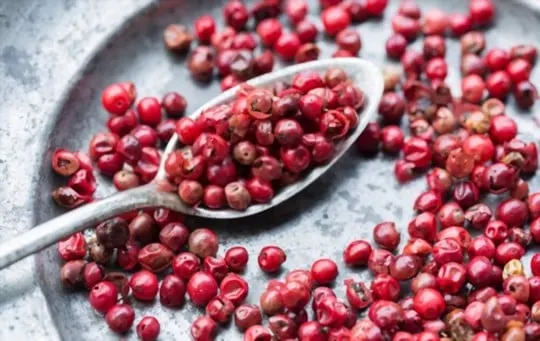
Pink peppercorns are relatively new to the pepper industry and were first commercially produced in France.
This is because it takes roughly ten years for the trees to produce fruit, making it difficult for farmers to profit from this crop.
Despite these obstacles, pink peppercorns are becoming increasingly popular in the west.
The fruit itself is a berry, and it’s typically dried out before being used for consumption.
Dried berries are ground into a fine mixture that resembles regular peppercorns.
The taste of pink peppercorns is sweet and slightly nutty, with fruity notes similar to raspberries or cherries.
It’s important to note that pink peppercorns are not interchangeable with black pepper.
The taste of the former is much more powerful and distinctive, so it’s best to use another recipe if you don’t have any available.
- Key Characteristics: Pink peppercorns have a mild heat level with a sweet and fruity taste. While not a true member of the pepper family, they can be used as a substitute for black pepper to bring a different flavor dimension to your dishes.
- Proper Ratio: Use an equal amount of pink peppercorns as a substitute for black pepper. Adjust the quantity based on your taste preferences and recipe requirements.
5 – Coriander Seeds
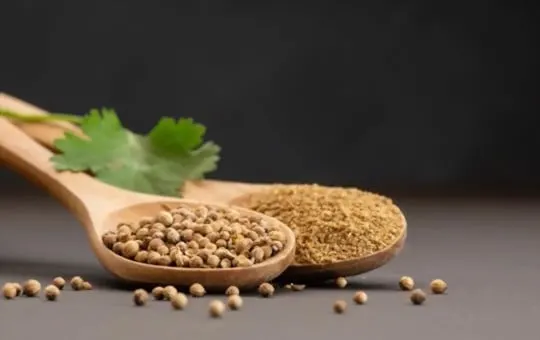
Coriander seeds are similar to black peppercorns, but there is one key difference.
This spice is much more fragrant and flavorful than its counterpart.
The flavor of this spice is described as being warm and earthy with a very mild citrus aftertaste.
The easiest way to recognize coriander seeds from black pepper is by looking at the color.
This kind of seed is much darker and often appears brown or tan instead of black.
This spice is used for seasoning and is essential in some very popular recipes.
One common example of this would be cilantro lime rice, which uses cilantro and coriander seeds to give it a unique taste.
- Key Characteristics: Coriander seeds offer a mild heat level with a warm, citrusy flavor. While not directly replacing the spiciness of black pepper, they can add a unique flavor profile to your dishes as a substitute.
- Proper Ratio: Use an equal amount of coriander seeds as a substitute for black pepper. Adjust the quantity based on your taste preferences and recipe requirements.
Conclusion
Black pepper is used worldwide in various recipes to enhance the flavor of different foods.
Although this spice is quite common, other spices can be used to substitute black pepper.
These include green peppercorns, Sichuan peppercorns, pink peppercorns, coriander seeds, and more.
Whether you’re looking for something similar to black pepper or want a new spice to try out, these alternatives are sure to satisfy.
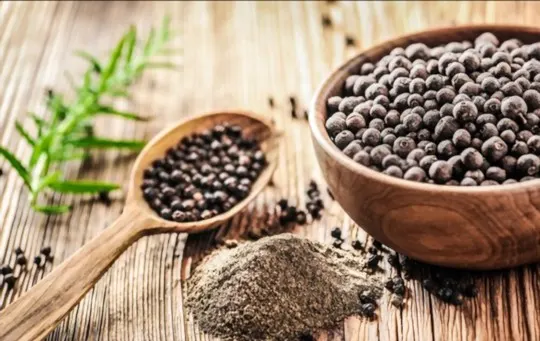
The 5 Best Substitutes for Black Pepper
Ingredients
- White Pepper
- Green Peppercorns
- Sichuan Pepper
- Pink Peppercorns
- Coriander Seeds
Instructions
- Pick your favorite substitute from the list above.
- Follow cooking directions for your selected substitute with the proper ratio of ingredients.

Andrew Gray is a seasoned food writer and blogger with a wealth of experience in the restaurant and catering industries. With a passion for all things delicious, Andrew has honed his culinary expertise through his work as a personal chef and caterer.
His love for food led him to venture into food writing, where he has contributed to various online publications, sharing his knowledge and insights on the culinary world. As the proud owner of AmericasRestaurant.com, Andrew covers a wide range of topics, including recipes, restaurant reviews, product recommendations, and culinary tips.
Through his website, he aims to inspire and educate fellow food enthusiasts, offering a comprehensive resource for all things food-related.

Leave a comment